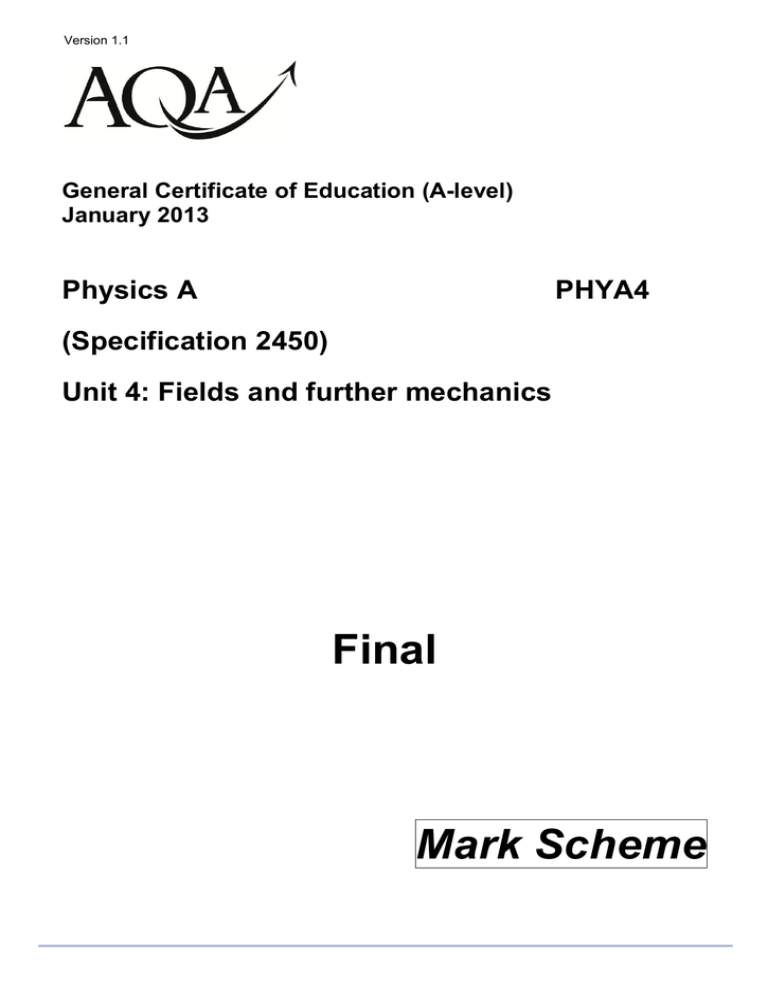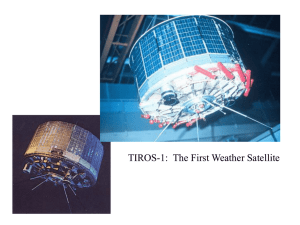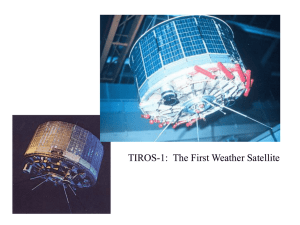
Version 1.1
General Certificate of Education (A-level)
January 2013
Physics A
PHYA4
(Specification 2450)
Unit 4: Fields and further mechanics
Final
Mark Scheme
Mark schemes are prepared by the Principal Examiner and considered, together with the
relevant questions, by a panel of subject teachers. This mark scheme includes any
amendments made at the standardisation events which all examiners participate in and is the
scheme which was used by them in this examination. The standardisation process ensures
that the mark scheme covers the students’ responses to questions and that every examiner
understands and applies it in the same correct way. As preparation for standardisation each
examiner analyses a number of students’ scripts: alternative answers not already covered by
the mark scheme are discussed and legislated for. If, after the standardisation process,
examiners encounter unusual answers which have not been raised they are required to refer
these to the Principal Examiner.
It must be stressed that a mark scheme is a working document, in many cases further
developed and expanded on the basis of students’ reactions to a particular paper.
Assumptions about future mark schemes on the basis of one year’s document should be
avoided; whilst the guiding principles of assessment remain constant, details will change,
depending on the content of a particular examination paper.
Further copies of this Mark Scheme are available from: aqa.org.uk
Copyright © 2012 AQA and its licensors. All rights reserved.
Copyright
AQA retains the copyright on all its publications. However, registered schools/colleges for AQA are permitted to copy material
from this booklet for their own internal use, with the following important exception: AQA cannot give permission to
schools/colleges to photocopy any material that is acknowledged to a third party even for internal use within the centre.
Set and published by the Assessment and Qualifications Alliance.
The Assessment and Qualifications Alliance (AQA) is a company limited by guarantee registered in England and Wales (company number 3644723) and a registered
charity (registered charity number 1073334).
Registered address: AQA, Devas Street, Manchester M15 6EX.
Mark Scheme – General Certificate of Education (A-level) Physics A – PHYA4 – January 2013
GCE Physics, Specification A, PHYA4, Fields and Further Mechanics
Section A
This component is an objective test for which the following list indicates the correct answers used in marking the candidates’ responses.
Keys to Objective Test Questions
1
2
3
4
5
6
7
8
9
10
11
12
13
A
D
D
C
A
D
B
A
B
C
A
B
C
14
15
16
17
18
19
20
21
22
23
24
25
D
B
B
C
D
C
B
A
C
D
B
A
Section B
Question
Part
1
a
1
b
Subpart
Marking guidance
Mark
Comment
Similarity: momentum is conserved (in both cases)
Difference: kinetic energy is conserved in an elastic collision but not
in an inelastic collision
2
For 2 mark allow ke is only conserved in
elastic collision, or ke is not conserved in
an inelastic collision.
i
in the Ce nucleus A = 140 Z = 58 and for A = 4 and Z = 2
1
All four correct values required
ii
0 = 140v 4 9.3 10
5
gives v = 2.6(6) 10 (m s1)
2
Allow 140v = 4 9.3 10 for 1 mark.
Allow ecf from values in (b)(i).
Allow inclusion of mass of 58 electrons in
recoil atom when shown.
nd
6
1
b
6
3
st
Mark Scheme – General Certificate of Education (A-level) Physics A – PHYA4 – January 2013
Ek of = ½ 4 1.66 1027 (9.3 10 ) (= 2.87 1013 J)
5 2
Ek of Ce = ½ 140 1.66 1027 (2.66 10 ) (= 8.22 1015 J)
6 2
E k of Ce 8.22 1015
= 0.0286 or 2.86%
E k of α 2.87 1013
1
b
iii
[or
E k of Ce 35v d
2
E k of α
v
2
gives
rd
35 2.66 105
9.3 10
6 2
For 3 mark, answer must be evaluated to
at least 2SF (3% alone is insufficient); note
5
that use of vd = 2.7 10 m s1 gives
0.0295 or 2.95%.
2
= 0.0286 or 2.86%
3
Allow ecf from values in (b)(ii).
]
rd
m
m
E k of Ce md v d
d
2
E k of α m v
m md
2
[or
2
=
When ecf is applied, 3 mark is only
available for answers between 2.5% and
3.5%.
m
1
m d 35
= 0.0286 or 2.86% ]
3/ 2
3/ 2
T r 3 / 2 or TE rE gives 60 24 rE
TP rP
105
7370
2/3
rE
60 24
from which
5.73
7370 105
and rE (= 5.73 7370) = 42 200 (km)
2
a
i
height above surface = 42 200 6370 = 35 800 or 35 900 (km)
answer to 3SF only
st
[or Newton’s law approach for 1 two marks:
2
2π
GMm
2
3 GMT
2 m r and
give r
2
T
4
π
r
11
24
6.67 10 5.98 10 (24 60 60) 2
3
22
rE =
(=7.54 10 )
2
4π
from which rE = 42 200 (km) ]
4
4
Full solution derived from Newton’s law of
gravitation is acceptable for all 4 marks.
rd
For 3 mark, final answer must be
expressed in km.
3SF mark is independent.
Mark Scheme – General Certificate of Education (A-level) Physics A – PHYA4 – January 2013
centripetal force (=m r) =
2
650 4π 2 7.37 106
105 602
= 4800 (4760) (N)
mv2
r
2π r 2π 7.37 106
and v
T
105 60
650 73502
gives v = 7350 (m s1) and centripetal force =
7.37 106
[or centripetal force
2
a
ii
2
= 4800 (4760) (N)
]
11
24
GMm 6.67 10 5.98 10 650
2
r2
7.37 106
[or centripetal force
= 4800 (4770) (N)
5
]
If both T and r values for the
geosynchronous satellite are substituted,
award 0 marks for (ii).
If only one correct T or r value for the polar
satellite is substituted, mark (ii) to max 1.
Mark Scheme – General Certificate of Education (A-level) Physics A – PHYA4 – January 2013
The candidate’s writing should be legible and the spelling,
punctuation and grammar should be sufficiently accurate for the
meaning to be clear.
The candidate’s answer will be assessed holistically. The answer will
be assigned to one of three levels according to the following criteria.
Four aspects must be considered in a high
level answer:-
High Level (Good to excellent): 5 or 6 marks
The information conveyed by the answer is clearly organised, logical
and coherent, using appropriate specialist vocabulary correctly. The
form and style of writing is appropriate to answer the question.
Features of polar orbit.
Features of geosynchronous orbit.
Why polar orbit is suitable for monitoring.
Why geosynchronous orbit is suitable for
communication.
The candidate gives a comprehensive comparison of the principal
features of the satellite orbits and explains the consequences for the
uses of the two types of satellites. There are clear statements
showing good understanding of why the polar satellite is suitable for
monitoring, and of why the geosynchronous satellite is useful for
communications.
2
b
Intermediate Level (Modest to adequate): 3 or 4 marks
The information conveyed by the answer may be less well organised
and not fully coherent. There is less use of specialist vocabulary, or
specialist vocabulary may be used incorrectly. The form and style of
writing is less appropriate.
The candidate’s comparison of the principal features of the orbits is
less complete and the consequences for the uses of satellites in them
are less well understood. The candidate has an acceptable
appreciation of why the polar satellite is suitable for monitoring, and of
why the geosynchronous satellite is useful for communications.
Low Level (Poor to limited): 1 or 2 marks
The information conveyed by the answer is poorly organised and may
not be relevant or coherent. There is little correct use of specialist
vocabulary. The form and style of writing may be only partly
appropriate.
6
max 6
Mark Scheme – General Certificate of Education (A-level) Physics A – PHYA4 – January 2013
The candidate has a much weaker knowledge of the principal
features of the orbits and very limited knowledge of consequences for
the uses of satellites in them. Understanding of why the polar
satellite is suitable for monitoring, and why the geosynchronous
satellite is suitable for communications, is limited or absent.
The explanation expected in a competent answer should include
a coherent selection of the following points.
Low polar orbit
Orbital period is a few hours
Earth rotates relative to the orbit
Many orbits with different radii and periods are possible
Orbit height is less than geosynchronous satellite
Speed is greater than that of geosynchronous satellite
Satellite scans the whole surface of the Earth
Applications: surveillance of conditions/installations on Earth,
mapping, weather observations, environmental monitoring
Gives access to every point on Earth’s surface every day
Can collect data from regions inaccessible to man
Contact with transmitting/receiving aerial is intermittent
Aerial is likely to need a tracking facility
Lower signal strength required than that for geosynchronous
satellite
Geosynchronous orbit above Equator
Orbital period matches Earth’s rotational period exactly
Satellite maintains same position relative to Earth
Only one particular orbit radius is possible
Travels west to east above Equator (in same direction as Earth’s
rotation)
Orbit height is greater than polar orbit satellite
Speed is less than that of polar orbiting satellite
Scans a restricted (and fixed) area of the Earth’s surface only
Applications: telecommunications generally, cable and satellite
TV, radio, digital information, etc.
Satellite is in continuous contact with transmitting/receiving aerial
Aerial can be in a fixed position
7
Mark Scheme – General Certificate of Education (A-level) Physics A – PHYA4 – January 2013
Higher signal strength required than that for polar satellite
Q Q e
3
t / RC
gives 1.0 = 4.0e300/RC
300
ln 4 and time constant RC = 220 (216) (ms)
from which
RC
0
a
[Alternative answer:
time constant is time for charge to decrease to Q0/e [or 0.37 Q0 ]
4.0/e = 1.47
reading from graph gives time constant = 216 10 (ms) ]
3
current is larger (for given V)(because resistance is lower)
[or correct application of I = V/R]
current is rate of flow of charge
[or correct application of I = Q/t]
3
larger rate of flow of charge (implies greater rate of discharge)
[or causes larger rate of transfer of electrons from one plate back to
the other]
b
In alternative scheme, 4.0/e = 1.47
st
subsumes 1 mark. Also, accept T½ =
st
0.693 RC (or = ln 2 RC) for 1 mark.
Use either first or alternative scheme; do
not mix and match.
max 2
Time constant = RC is insufficient for time
constant explained.
[Alternative answer:
time constant (or RC) is decreased (when R is decreased)
explanation using Q = Q0et/RC or time constant explained ]
4
4
a
force between two (point) charges is proportional to (product of)
charges
and inversely proportional to the square of their distance apart
2
b
lines with arrows radiating outwards from each charge
more lines associated with 6nC charge than with 4nC
lines start radially and become non-radial with correct curvature
further away from each charge correct asymmetric pattern (with
neutral pt closer to 4nC charge)
max 3
i
8
Formula not acceptable. Accept “charged
particles” for charges. Accept separation
for distance apart.
Mark Scheme – General Certificate of Education (A-level) Physics A – PHYA4 – January 2013
4
b
ii
Q1Q2
4πε r 2
0
force
4.0 109 6.0 109
4π 8.85 1012 (68 103 ) 2
2
Treat substitution errors such as 106
(instead of 109) as AE with ECF available.
4
For both of 1 two marks to be awarded,
substitution for either or both of E4 or E6
(or a substitution in an expression for
E6 E4) must be shown.
If no substitution is shown, but evaluation is
st
correct for E4 and E6, award one of 1 two
marks.
Use of r = 68 103 is a physics error with
no ECF.
Unit mark is independent.
= 4.6(7) 105 (N)
E4
4
c
i
4.0 109
4πε 0 34 103
st
6.0 109
E6
3
4πε 0 34 10
1
(= 3.11 10 V m ) (to the right)
4
2
2
= (4.67 104 V m1) (to the left)
Eresultant = (4.67 3.11) 10 = 1.5(6) 10
Unit: V m1 (or N C1)
4
4
c
5
a
5
b
ii
i
direction: towards 4 nC charge or to the left
1
direction of induced emf (or current)
opposes change (of magnetic flux) that produces it
2
(volumes are equal and mass of Q is greater than that of P)
density of steel > density of aluminium
1
Allow density of Q greater (than density of
P).
2
Backwards working is acceptable for 1
mark.
nd
2 mark must refer to mass.
nd
Do not allow “both in free fall” for 2 mark.
2
2
use of s = ½ g t gives t
5
b
ii
4
2 1.0
(from which t = 0.45 s)
9.81
(vertical) acceleration [or acceleration due to gravity]
is independent of mass of falling object
[or correct reference to F = mg = ma with m cancelling ]
9
st
Mark Scheme – General Certificate of Education (A-level) Physics A – PHYA4 – January 2013
5
5
5
c
c
d
i
moving magnet [or magnetic field] passes through tube
there is a change of flux (linkage)(in the tube)
[or flux lines are cut or appropriate reference to = N (/t) ]
[Alternative:
(conduction) electrons in copper (or tube) acted on by (moving)
magnetic field of Q
induced emf (or current) is produced by redistributed electrons ]
ii
emf produces current (in copper)
this current [allow emf] produces a magnetic field
this field opposes magnetic field (or motion) of Q
[or acts to reduce relative motion or produces upward force]
no emf is induced by P because it is not magnetised (or not magnet)
[or movement of P is not opposed by an induced emf or current]
time for P is unaffected because there is still no (induced) emf
[or because P is not magnetised
or because there is no repulsive force on P]
time for Q is shorter (than in (c))
current induced by Q would be smaller
because resistance of brass resistivity and is therefore higher
[or resistance of brass is higher because resistivity is greater]
giving weaker (opposing) magnetic field
[or less opposition to Q’s movement]
10
2
In this part marks can be awarded for
answers which mix and match these
schemes.
rd
max 3
Alternative to 3 mark:
current gives heating effect in copper
and energy for this comes from ke of Q
nd
max 3
Condone “will pass through faster” for 2
mark.
If emf is stated to be smaller for Q, mark (d)
to max 2.




